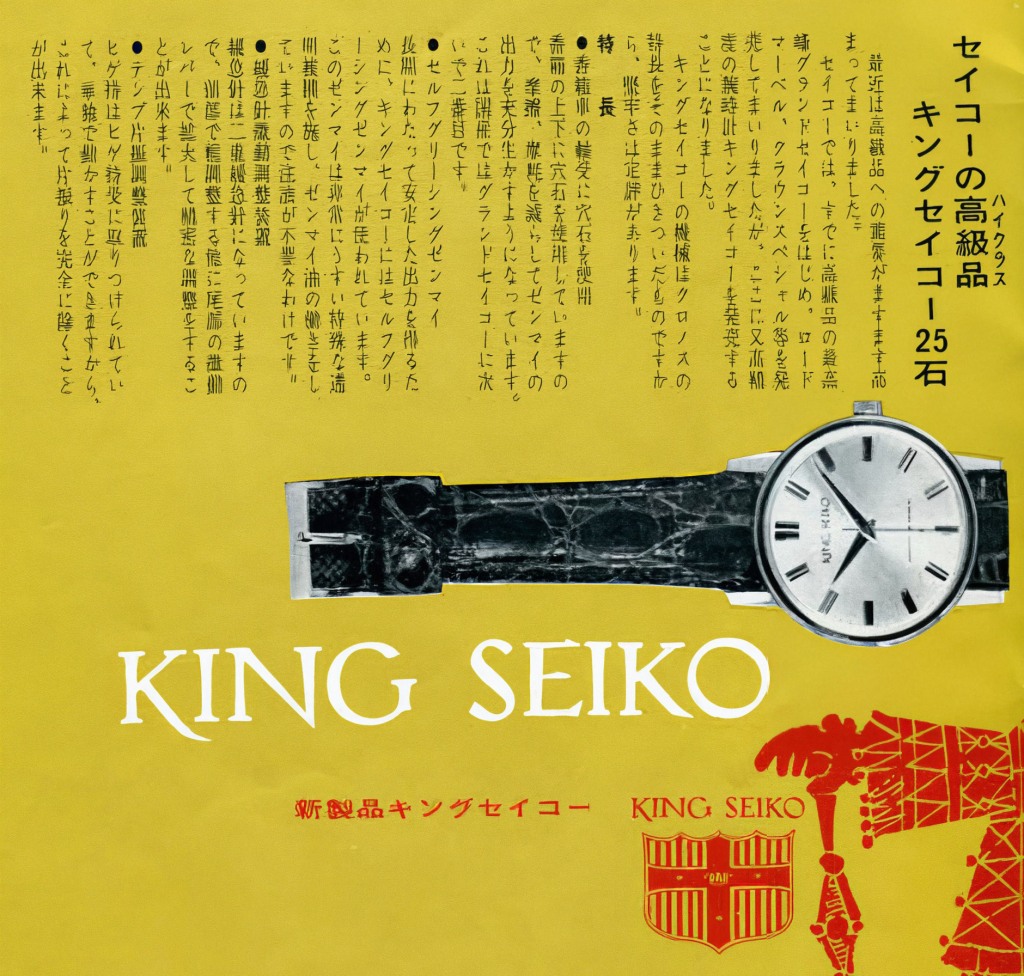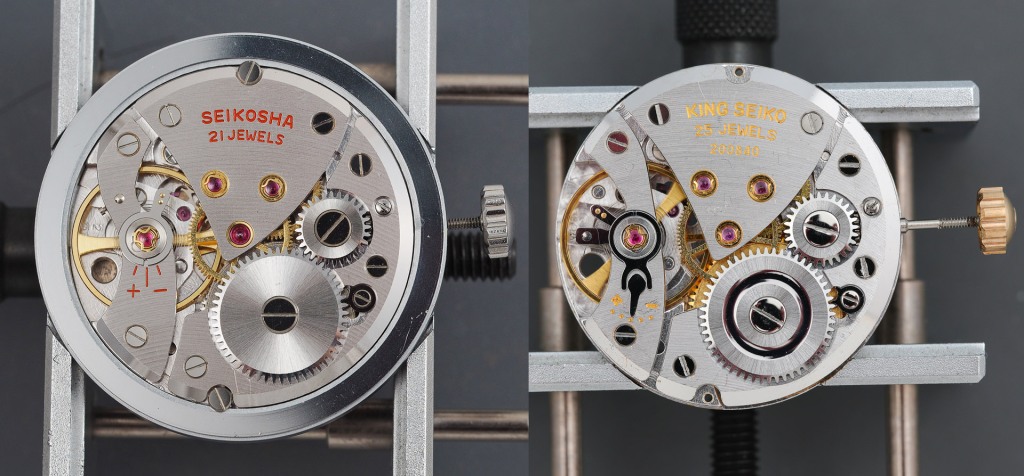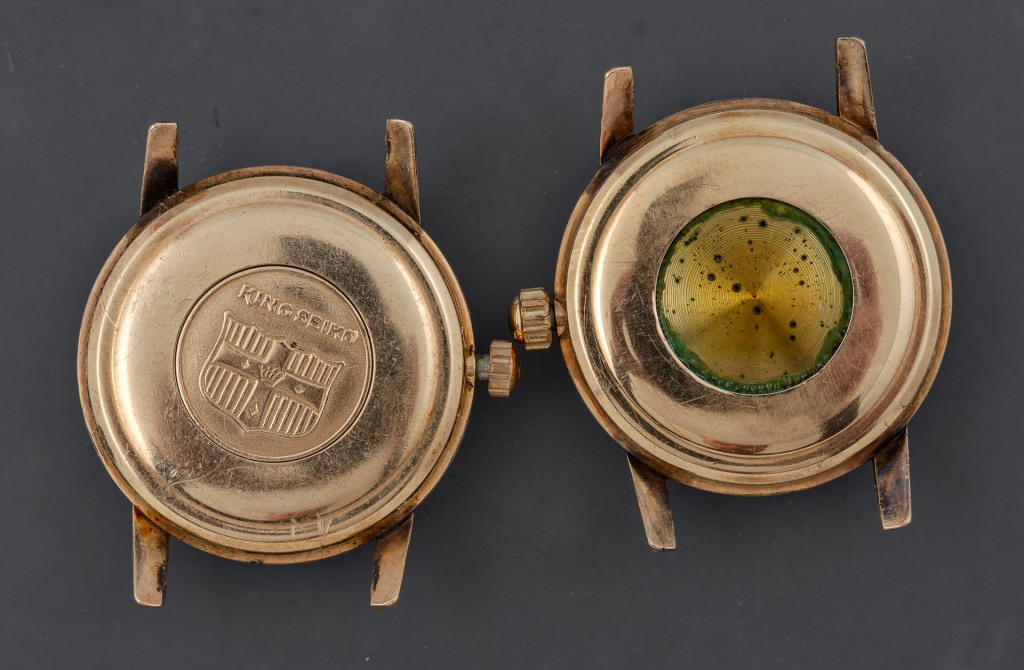Just as the king is the second-highest ranked card in a deck of cards, so, from its outset, has the King Seiko played second fiddle to the ace in the pack, the Grand Seiko. It is tempting to believe that Seiko’s Daini division intended for the King Seiko to stand toe-to-toe with Suwa’s Grand Seiko, but even were that to have been the case, the undeniable reality is that the King Seiko was marketed by Seiko at the outset as offering a taste of the top-drawer quality of the Grand Seiko but at a more affordable price-point.

The September 1961 edition of Seiko News announced the release of the King Seiko, a new, high class luxury watch. The opening lines of the accompanying marketing blurb acknowledges the recent increase in demand for luxury goods and references the Grand Seiko (released the previous year), Lord Marvel and Crown Special as examples of luxury Seiko watches. With that track record then, where does the King Seiko fit in and what does it offer? Interestingly, the blurb goes into some technical detail in setting out its case: the movement inherits the robust qualities of the Cronos movement, on which the King Seiko movement was based (below, Cronos left, King Seiko, right);

The use of jewelled holes in the top and bottom of the barrel reduces friction, allowing full use of the mainspring’s output; the self-greasing mainspring provides stable output over a long period of time; the use of an adjustable stud lever as well as regulator arm (note the lack of an adjustable stud-holder on the Cronos movement in the photo above) allows for elimination of beat error. All of these attributes, says the September 1961 edition of Seiko News, “place the King Seiko as second only to the Grand Seiko in domestic products”.
I have written before on several occasions about the seemingly competitive relationship between the Daini and Suwa divisions and, in a chronological random walk, about the history of the Grand Seiko and King Seiko sub-brands. However, I am conscious that, in spite of having worked on numerous examples of both, I have not until now, had the opportunity to work on and write about the first editions of either brand. In my resolve to address that shortcoming, at least with respect to King Seiko for the moment, I found myself casting about for likely prospects and unwittingly landed two examples of almost, but not quite exactly, the same variant of the first King Seiko.

The watch on the left, in the photo above, is an example of the King Seiko J14102E, produced from July 1961 until August 1963. The one on the right is an example of a J14102, without the ‘E’ suffix, produced from October 1962 to September 1963.1 Both watches employ conservatively-styled, gold-filled three-part cases of 34.8mm diameter with slender, lightly bevelled lugs, welded to the case. The earlier J14102E is 100 micron gold-filled, whereas the J14102 used a slightly less extravalent 80 micron layer of gold cap.
The reason for buying two examples of this model should become clear when we survey the two casebacks.

The older of the two, on the right, was my first purchase and this one is clearly missing its King Seiko medallion. I added the one on the left in the interests of having as complete an example as I could but unwittingly I have ended up with a pair that are sufficiently different from one another to assist in illustrating the early history of the brand. The insides of the two case backs provide a little more insight.

Again, the older of the two is to the right, the younger to the left. The imprint of the crane at the top of each case back signifies that these are products of the Daini factory in Tokyo. The serial number of the older watch begins 25 which dates it to May 1962 and the one on the left starts 31 dating it to January 1963. The most significant differences between the two are the model numbers and the presence of the 100 microns text on the interior of the case back of the older watch. The movements provide some small additional insights.

The train bridges of each stack three lines of text starting with the simple model identifier ‘King Seiko’, these being the first ever King Seikos and therefore not in need of anything else to trumpet their identities. Beneath that the jewel count and below that another serial number. There is no significance to be drawn from the numbers themselves other than that they are sequential. The lower number, 139484, belongs to the older watch, the higher, 200840, belongs to the watch produced eight months later. Having set the scene, I propose to split this account into three parts, this first part serving as an introduction. Each of the two watches will then act as the subject of an account of its own de- and re-construction in parts 2 and 3. Part 2 will follow the fortunes of the younger of the two watches, the J14102 from January 1963 because this is the order in which I tackled them, and Part 3 of the older watch, the J14102E.
1 My research efforts have been greatly helped by the wealth of information available at http://www.egalizer.hu/targyak/orak/king1.htm

Regarding KS vs GS at the beginning it was not a marketing decision to have KS sit below GS in the hierarchy but a technical one. Myself and a colleague researched this a few years back and that research included talking to the retired Seiko managers from the early 60s. They told us that initially, the Daini factory lacked the testing infrastructure to ensure Chronometer grade regulation. Only the Suwa plant had that capability. Therefore the first King Seiko model could not be graded a chronometer and so had to be sold at a lower level.
Hi David,
I didn’t suggest that it was a marketing decision to have King Seiko sit below Grand Seiko but that Seiko marketed King Seiko as the second tier product. That is undeniably the case both in terms of the language they used in their marketing material but also in the gulf between the two in terms of pricing. I am sure the different testing regimens will have contributed to that but perhaps the pricing reflected material differences between the two as well. Thank you for your insights – really appreciated.
Nice write up and I look forward to reading the follow ups. For me, these early model KS are as good as GS all day long. I absolutely love the fat lugs of the second model 44999, but these first models hug your wrist and really are a delight to wear. Mines a 1961 14102E SD. Let me know if you need any high res photos of the box, outerbox, card & tag and I’ll ping them over to you
I have been really taken with the two examples I have. Whether they have the star quality of the first Grand Seiko is subjective and I’ll reserve judgement on that for the moment but what is not in doubt for me is the quality of the movement. It’s fantastic. And yes, please do send over some photos of the boxes. Thank you!